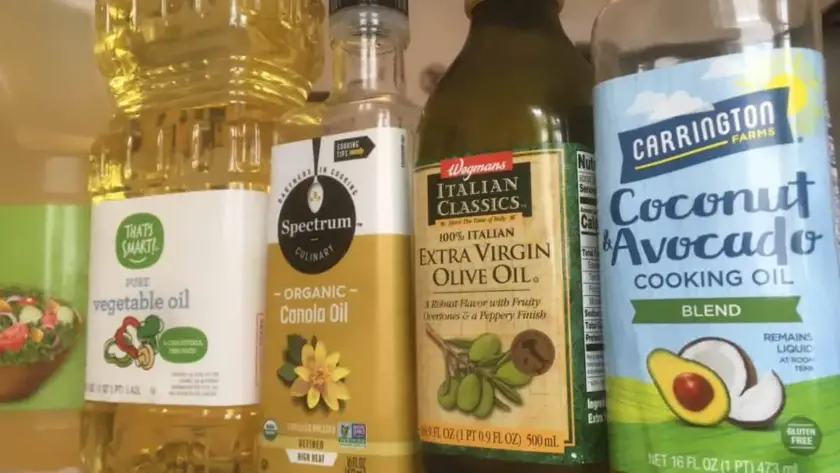Cooking oils are a staple ingredient in every kitchen, used to sauté, fry, and bake countless dishes. However, with the vast array of cooking oils available in the market, it can be challenging to determine which one is the healthiest for our bodies.
In the United States, seven types of cooking oil are most commonly purchased, and each of them comes with its own set of health risks. In this article, we will explore the potential health hazards associated with these cooking oils and learn about recommendations on how to make informed choices about the oils we use in our daily cooking.
The first type of oil I am going to start off with is actually a brand, and they have many different types of oil, and even a blend. Find out why to avoid this oil specifically, below.
Wesson
Wesson cooking oil is a brand of vegetable oil that is made from a combination of different plant sources such as soybeans, corn, canola, and sunflowers.
The health risks associated with using Wesson cooking oil, or any other vegetable oil, are primarily related to its high levels of polyunsaturated fatty acids, specifically omega-6 fatty acids. While these fatty acids are essential for our bodies, consuming excessive amounts of them can lead to inflammation, which is linked to a range of chronic diseases such as heart disease, cancer, and diabetes.
Additionally, the refining process used to produce Wesson cooking oil may remove some of the beneficial compounds found in the original plant sources, such as antioxidants and other nutrients. This makes the oil less nutritious than unrefined, cold-pressed oils.
There is a current lawsuit against Conagra, who is the company that owns Wesson. The lawsuit alleges that Defendant Conagra violated certain laws in the marketing, advertising, and sale of Wesson brand cooking oils, including Wesson Vegetable Oil, Wesson Canola Oil, Wesson Corn Oil, and Wesson Best Blend (“Wesson Oil Products”), made from Genetically Modified Ingredients (“GMOs”) as “Natural.”
8 Types Of Oil That Should Be Avoided
- Corn oil
- Canola/Rapeseed oil
- Cottonseed oil
- Soy oil
- Sunflower oil
- Safflower oil
- Grapeseed oil
- Rice bran oil
These oils are extremely unhealthy for two reasons:
They’re highly refined, and they’re high in polyunsaturated fatty acids (PUFA).
So, What’s Wrong With PUFA’s?
Though polyunsaturated are typically healthy in moderation, the fats contained in these oils are highly unstable. Meaning, when they’re exposed to chemicals in the refining process, they’re stripped of their antioxidants, vitamins, and minerals.
A little bit of background: there are three main types of fat. When you eat butter, olive oil or the fat trimmed off a steak, you’re eating a combination of…
Saturated fatty acids (SFAs)
Monounsaturated fatty acids (MUFAs)
Polyunsaturated fatty acids (PUFAs)
(There are a few very minor other types, but we’re keeping it simple for now and these are the big ones).
The basic difference between these three types of fat is the way they’re structured. Without going into the scientific details, the structure of PUFAs makes them chemically unstable.
More specifically, PUFAs are very vulnerable to damage from heat, light, and oxygen. If they’re damaged by heat, light, and/or oxygen (for example, if they’re used as frying oil over and over again, or just left out in a clear bottle on the shelf for months in a supermarket), they can get oxidized.
Oxidized fats are dangerous because they’re inflammatory. Eating oxidized fats increases inflammation, and inflammation contributes to just about every chronic disease you could name, including heavy-hitters like obesity and diabetes.
For example, in this study, researchers oxidized some soybean oil by heating it up a bunch of times. Then they fed it to rats. The oxidized soybean oil caused inflammation, which raised the rats’ blood pressure and contributed to hypertension.
This study found that oxidized PUFAs were the main cause of liver damage and Type 2 Diabetes in children with obesity. Even aside from the question of oxidation, the most common type of PUFA in the typical American diet stimulates an inflammatory response all on its own.
All that inflammation is the obvious cause of inflammatory diseases, which happen to be some of the most common diseases around today. Inflammatory diseases include diabetes, obesity, metabolic syndrome, autoimmune disease, cardiovascular disease, several types of cancers, fatty liver disease, depression…
(This isn’t to say that inflammation alone “causes” all these diseases, just that it contributes to them).
US consumption of PUFA has increased dramatically, from about 3% of total calories in 1909 to about 8% in 1999. The shift happened because we moved away from traditional, low-PUFA cooking fats like butter and towards high-PUFA industrial fats like soybean oil.
There are two main types of PUFA:
Omega-3 and Omega-6
Omega-3 fats: found in fish, seafood, and plants.
Omega-6 fats: found in industrial oils (corn oil, “vegetable oil,” peanut oil, soy oil, etc.)
The real issue is somewhat complicated. We are ingesting too much PUFA in total. Excess amounts of Omega-6, but actually deficient in Omega-3s.
Our ancestral diets typically contained Omega-6 and Omega-3 PUFA in a ratio between 4:1 and 1:1. Our modern diets have Omega-6 and Omega-3 PUFA in a ratio closer to 10:1, or higher.
In general, a high ratio of Omega-6 to Omega-3 is pro-inflammatory. An imbalance of Omega-6 to Omega-3 harms gut health and may increase depression, chronic stress, chronic pain, autism spectrum disorders, inflammatory bowel disease, rheumatoid arthritis, and liver disease and cardiovascular disease.
So What Should You Eat?
1. Mackerel
Mackerel are small, fatty fish. In many countries, they are commonly smoked and eaten as whole fillets. Mackerel are incredibly rich in nutrients — a 3.5-ounce (100-gram) serving packs 500% of the Reference Daily Intake (RDI) for vitamin B12 and 130% for selenium. Omega-3 content: 4,580 mg of EPA and DHA (combined) in 3.5 ounces, What’s more, these fish are delicious and require little preparation.
2. Salmon
Salmon is one of the most nutrient-dense foods on the planet. It contains high quality protein and a variety of nutrients, including large amounts of vitamin D, selenium, and B vitamins. Omega-3 content: 2,150 mg of EPA and DHA.
Studies show that people who regularly eat fatty fish such as salmon have a lower risk of conditions like heart disease, dementia, and depression.
3. Cod liver oil
Cod liver oil is more of a supplement than a food. This oil is not only high in omega-3 fatty acids but also loaded with vitamins D and A. Omega-3 content: 2,438 mg of EPA and DHA.
4. Herring
Herring is a medium-size oily fish. It is often cold-smoked, pickled, or precooked and then sold as a canned snack. A 3.5-ounce serving of herring contains almost 100% of the DV for selenium and 779% of the DV for vitamin B12. Omega-3 content: 2,150 mg of EPA and DHA.
5. Oysters
Shellfish are among the most nutritious foods you can eat. In fact, oysters contain more zinc than any other food on the planet. Just 6 raw eastern oysters pack 289% of the DV for zinc, 69% for copper, and 567% for vitamin B12. Omega-3 content: 329 mg of EPA and DHA.
6. Sardines
Sardines are very small oily fish that is highly nutritious, especially when eaten whole. They contain almost every nutrient your body needs. A 3.5-ounce serving of drained sardines provides more than 370% of the DV for vitamin B12, 24% for vitamin D, and 96% for selenium. Omega-3 content: 1,463 mg of EPA and DHA.
7. Anchovies
Anchovies are tiny oily fish often bought dried or canned. Because of their strong taste, they are also used to flavor many dishes and sauces, including Worcestershire sauce, remoulade, and Caesar dressing. Anchovies are a great source of niacin and selenium, and boned anchovies are a decent source of calcium. Omega-3 content: 411 mg of EPA and DHA.
8. Caviar
Caviar is a good source of choline and a rich source of omega-3 fatty acids. Omega-3 content: 1,046 mg of EPA and DHA.
9. Flaxseed
These small brown or yellow seeds are by far the richest whole food source of the omega-3 fat alpha-linolenic acid (ALA). Therefore, flaxseed oil is often used as an omega-3 supplement. Flaxseed is also a good source of fiber, magnesium, and other nutrients. The seeds have a great omega-6 to omega-3 ratio as compared with most other oily plant seeds. Omega-3 content: 2,350 mg of ALA per tablespoon of whole seeds.
10. Chia seeds
Chia seeds are incredibly nutritious — rich in manganese, selenium, magnesium, and a few other nutrients. A 1-ounce serving of chia seeds contains 5 grams of protein, including all eight essential amino acids. Omega-3 content: 5,050 mg of ALA per ounce.
11. Walnuts
Walnuts are very nutritious and loaded with fiber. They also contain high amounts of copper, manganese, and vitamin E. Make sure not to remove the skin, as it packs most of walnuts’ phenol antioxidants, which offer important health benefits. Omega-3 content: 2,570 mg of ALA per ounce.
13. Other foods?
Keep in mind that sections 1–8 discuss foods that contain the omega-3 fats EPA and DHA, which are found in some animal foods, seafood, and algae.
Although not as high in omega-3 as the foods above, many other foods contain decent amounts. These include pastured eggs, omega-3-enriched eggs, meats and dairy products from grass-fed animals, hemp seeds, and vegetables such as spinach, Brussels sprouts, and purslane.
For cooking fats, use coconut oil, butter, and olive oil.
Avoid These “Healthy Foods” That Contain Hidden Unhealthy Cooking Oils
A key thing to remember is that the vast majority of restaurants use vegetable oils to cook their food. And we’re not just talking fast food—many high-end restaurants do the same. Most packaged foods lining grocery store shelves contain vegetable oils, as do harmless-seeming products like oat milk and even baby formula. Here are some common foods that usually include vegetable oil:
Margarine
Coffee Creamer
Dairy-Free Cheese
Oat Milk
Vegetable Shortening
Salad Dressing
Granola
Pre-Packaged Nuts and Seeds
Pre-Packaged Snack Foods
Baby Formula

What Should You Do To Avoid Unhealthy Cooking Oils?
1. Check Ingredient Labels
Before adding an item to your grocery cart, do a quick scan of the ingredient label. Keep an eye out for the following words or phrases…
Hydrogenated Vegetable Oils
Hydrogenated Oils
Partially Hydrogenated Oils
Trans Fats
Soybean Oil
Corn Oil
Cottonseed Oil
Sunflower Oil
Safflower Oil
Grapeseed Oil
Canola Oil
Rapeseed Oil
Peanut Oil
Rice Bran Oil
2. Ask Your Server
When eating out at a restaurant, ask your server what oils they use to prepare your food. LocalFats.com is a handy website that shows you which restaurants in your area use healthy fats in their kitchen.
3. Audit Your Fridge and Pantry
Search your kitchen for foods, drinks, or other products that contain the oils listed above.
4. Choose Healthier Alternatives
Olive oil, avocado oil, and coconut oil are three of the most popular substitutes for vegetable oil, but they’re not the only ones. There is a wide range of healthier oils and fats to try:
The 5 Healthiest Oils To Cook With And What To Avoid At All Costs
3 Of The Best Cooking Oils:
Grass-fed butter, grass-fed beef tallow, and olive oil are often considered some of the best cooking fats due to their unique health benefits and culinary qualities. Grass-fed butter is rich in beneficial fats, including conjugated linoleic acid (CLA) and omega-3 fatty acids, which are known for their anti-inflammatory properties. It also contains vitamins A, D, E, and K2, which are essential for various bodily functions. The butter’s rich, creamy flavor enhances the taste of dishes, making it a favorite in both savory and sweet recipes.
Grass-fed beef tallow, derived from the fat of cattle raised on pasture, is another nutrient-dense option. It is high in saturated fats, which are stable at high temperatures, making it ideal for frying and roasting. Tallow contains stearic acid, which has been shown to support metabolic health and may help reduce inflammation. It also imparts a rich, savory flavor to dishes, particularly those requiring deep frying or high-heat cooking.
Olive oil, particularly extra virgin olive oil, is prized for its high monounsaturated fat content, primarily oleic acid, which is associated with reduced risk of heart disease and balanced cholesterol levels. It is also rich in antioxidants, including vitamin E and polyphenols, which can protect cells from oxidative damage. Olive oil’s versatility in the kitchen, with its fruity and peppery flavor profile, makes it suitable for everything from salad dressings and marinades to sautéing and light frying.
Together, these fats offer a combination of health benefits and culinary versatility, making them superior choices for cooking. Their natural flavors and nutritional profiles provide an excellent foundation for a healthy and flavorful diet.
The Bottom Line
Vegetable oils are a hidden danger to our health. Most of us are surrounded by them, as they’re in countless foods and restaurant meals. Take steps to switch out vegetable oils for alternatives like olive oil, avocado oil, and coconut oil, and be aware of the ingredients in the foods you eat. You can cut back on vegetable oils—it just takes awareness.











